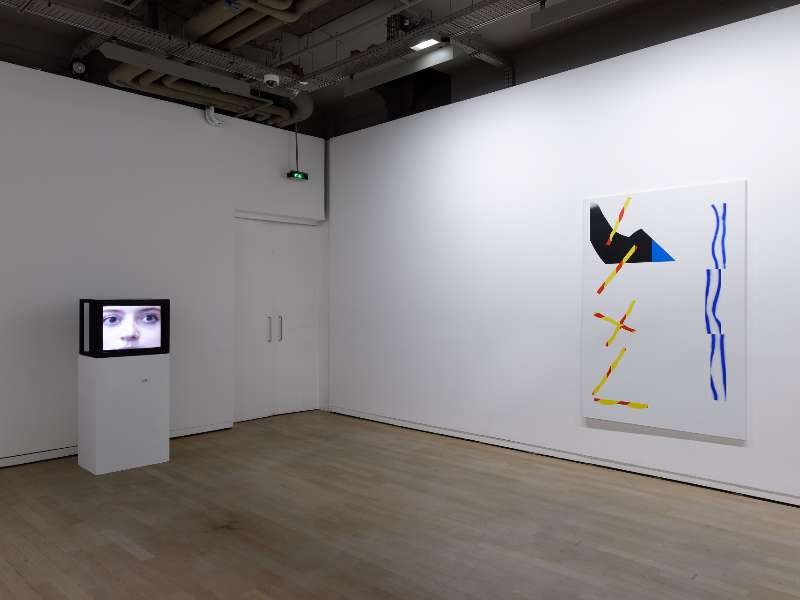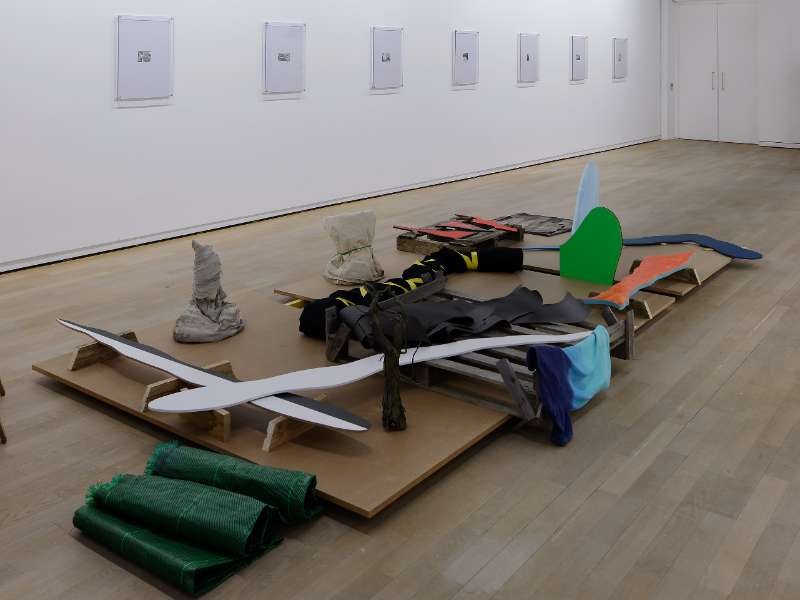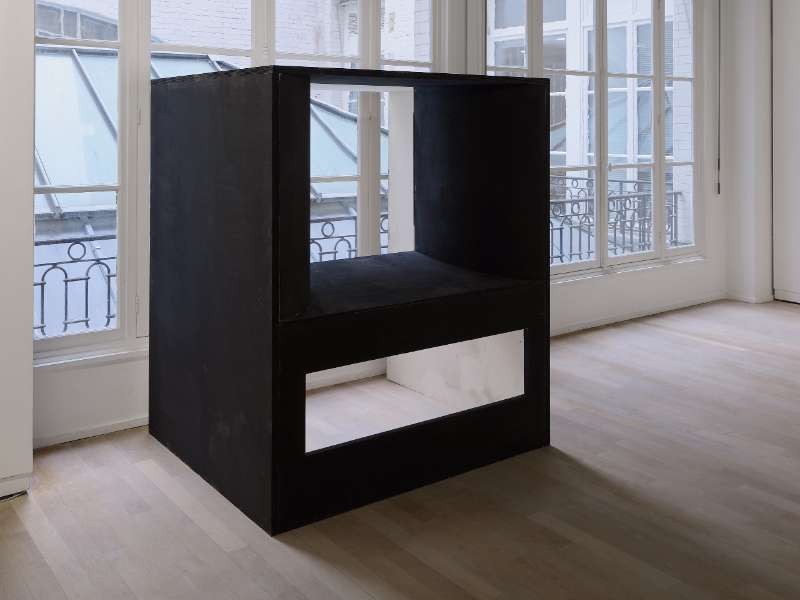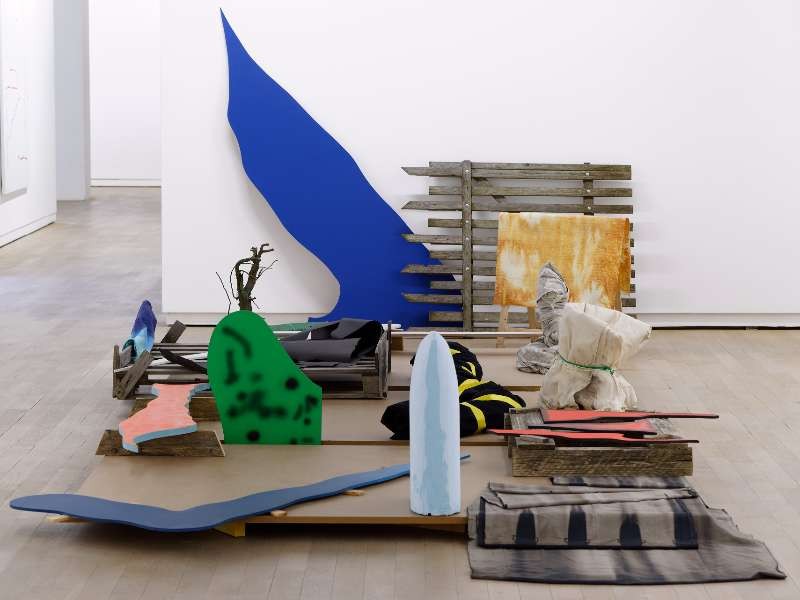Maurice Blaussyld & Samuel Richardot
27 Nov 2017 - 13 Jan 2018
MAURICE BLAUSSYLD & SAMUEL RICHARDOT
Duographie
28 November 2017 – 13 January 2018
Curated by Anne Bonnin
At first sight, Maurice Blaussyld and Samuel Richardot are such different artists that it is hard to understand what unites them. Let us say straight off: they both have a relationship with silence. Blaussyld’s is hieratic, while Richardot’s is colorful. When the Fondation d’entreprise Ricard asked me to bring them together in an exhibition, I imagined this Duographie as the meeting of two contrasting silences that would not have been expected to live side-by-side. Although this meeting is not a matter of chance, it is one of those revealing coincidences: as I spent time with both of them concomitantly, connections became apparent, revealing the possibility of a duography.
“There is no such thing as silence. Something is always happening that makes a sound.
No one can have an idea once he starts really listening. It is very simple but extra-urgent.”[1]
Silence is always the silence of something, and it therefore always reflects a unique experience.
Clean shapes, neutral tones of grey, black and white: Blaussyld’s pieces (installations, sculptures, drawings) offer a lean, iterative, economical esthetic, the artist producing a limited body of work over the past 30 years. They assert themselves through their mutism. “Peinture Noire” (“Black Painting”), originally inspired by a dismantled acoustic speaker, is in reality an open-backed volume. With its two holes, it presents a kind of gaping: its A-shape is not alien to language. It also forms a grotesque face that evokes a totem, a mask, or a silent scream like Münch’s. “Peinture Noir” is not a title but a name; this is what the artist usually calls it. This designation, which creates uncertainty, reflects the paradoxical function of the work: at once sculpture and painting, or neither one nor the other. This name affiliates it with the Suprematist painting of Kazimir Malevitch, in search of a pure reality and a world without objects. “Peinture noire” is the apparition and eclipse of an object.
The artist conceives of his work as apparitions reproduced at each exhibition. Each apparition is therefore unique, the idea coinciding with its realization: a practice that seems Platonic to say the least. Blaussyld defines his art as an ontology, whereas his vocabulary is however that of a mystic, without a god: “vision”, “apparition”, “being”, “one”.
One gradually realizes that these words expressing an aim—vision—are also tools that the artist uses to shape his works. Speech is thus part of the work, which is its emanation. This extreme coherence can meet with fascination or indifference—it all amounts to the same thing with this hieratic art. It autonomizes a work that reveals its complexity if it is approached, since it does not give itself away at first glance...
Blaussyld’s art is clearly enigmatic. It is shaped by an unresolved contradiction, left in suspense: an impossible dialectic according to which “the positive is always obtained through the presence of the negative, but a negative that denies the very thing being asserted” (Emmanuel Levinas). There is a touch of Blanchot in the work of Blaussyld, who shares not only the writer’s initials and first name, but also his obsession with silence and death. The artist has explained to Bernard Lamarche-Vadel that his “art has a relationship with death”. A muted brutality emanates from this art that strives toward a point of contradictory intensity, in which one can also recognize the brutality of the Barthesian neutral.
The installation “Sentiment de la distance” (“Feeling of Distance”) is a vision apparatus: a veritable autopsy of the act of seeing. A white box measuring twenty-four square meters—out of proportion with the Foundation’s spaces—imposes its massive presence. A glass wall, covered with a large sheet of graduated paper that leaves two lateral bands of daylight, allows the interior to be seen. On the floor to the left is a large tape recorder, and facing the wall is a small black-and-white photo of an autopsy. It is a chilling arrangement to say the least, evoking a Kafkaesque torture device. It generates an unexpected tactile impression: we see, we sense an absence invading those twenty-four square meters: silence fleshing out, like a negative epiphany.
Richardot’s art takes us toward a completely different silence, which his broad white backgrounds reflect. They are characterized by an exploded composition: silence is dotted with fragmentary, dazzling apparitions. Detached figures float in an undefined, depthless, neutral space; their scattered distribution seems random. In “Palladium”, a large, blue-red-black-yellow zigzag stands beside two small whitish clouds, some regular polychromatic lines and a striped banner: all of these figures reveal colored hinterlands, under the white screen... The backgrounds are not just backgrounds, they are part of a fluid, metaphorical pictorial economy. The colored and graphical motifs recur from one painting to another, forming a vocabulary, like a large family of different individuals—stripes, streaks, harlequin diamonds, marbling, circles, as well as straight, curled or erratic lines. Richardot’s clean, flat-textured painting, which asserts its surface condition, is smooth like a photo, playing upon illusionist effects as well. The fragmentary motifs evince and evade resemblances: they are strangely familiar, suggesting the intensity of recollection, a memory of oblivion or a surrender to what lies ahead.
Richardot’s chromatic and graphic art is brilliant and joyful... dynamic... leaping. It connects with a sense-memory, awakens memories of painting, textures or blissful moments. It grabs attention; because these figures, however undefined they may be, are precise with their clear contours, pure colors and details, which sometimes produce a trompe-l’oeil.
The colors confront each other, sometimes brutally, superimposing or merging. The geometry is derailed, fractured and hybrid, carried away by a lineal freedom. With its solid colors, Richardot’s painting naturally evokes Matisse and cartoons, but one also encounters flashes of Odilon Redon or Morris Louis in certain paintings covered all over with polychromatic streaks. One also recognizes a bit of Seurat in the lights and in flashes of the atmospheres of circuses, games and seaside leisure, or Picabia in how a balloon is sketched, and also some Gerhard Richter... But these echoes, which are too elliptical to be citations, are primarily the product of an eye put into action by a kind of painting that plays with itself, that is to say with illusion, artifice, representation, and therefore with its viewers.
Richardot’s painting is the scene of a game of improvisation that also brings us back to the present. The paintings are upended by their titles, which refer to concrete, heterotopic situations of collective self-creation: Football, Barbecue, Palladium, Bidonville (Shantytown).
The meeting of the two artists is stimulating to say the least. Two silences communicate: one metaphysical, operating slowly, at a distance; the other more spontaneous, connecting the present moment with an esthetic memory. Although very different, they intersect in being non-representative art, suggestive though incisive, an art of the threshold that gives way to silence, to a variety of silences... Because making silence is “extra-urgent”.
[1] John Cage, Silence: Lectures and Writings, 1961, p. 191, Wesleyan University Press
Duographie
28 November 2017 – 13 January 2018
Curated by Anne Bonnin
At first sight, Maurice Blaussyld and Samuel Richardot are such different artists that it is hard to understand what unites them. Let us say straight off: they both have a relationship with silence. Blaussyld’s is hieratic, while Richardot’s is colorful. When the Fondation d’entreprise Ricard asked me to bring them together in an exhibition, I imagined this Duographie as the meeting of two contrasting silences that would not have been expected to live side-by-side. Although this meeting is not a matter of chance, it is one of those revealing coincidences: as I spent time with both of them concomitantly, connections became apparent, revealing the possibility of a duography.
“There is no such thing as silence. Something is always happening that makes a sound.
No one can have an idea once he starts really listening. It is very simple but extra-urgent.”[1]
Silence is always the silence of something, and it therefore always reflects a unique experience.
Clean shapes, neutral tones of grey, black and white: Blaussyld’s pieces (installations, sculptures, drawings) offer a lean, iterative, economical esthetic, the artist producing a limited body of work over the past 30 years. They assert themselves through their mutism. “Peinture Noire” (“Black Painting”), originally inspired by a dismantled acoustic speaker, is in reality an open-backed volume. With its two holes, it presents a kind of gaping: its A-shape is not alien to language. It also forms a grotesque face that evokes a totem, a mask, or a silent scream like Münch’s. “Peinture Noir” is not a title but a name; this is what the artist usually calls it. This designation, which creates uncertainty, reflects the paradoxical function of the work: at once sculpture and painting, or neither one nor the other. This name affiliates it with the Suprematist painting of Kazimir Malevitch, in search of a pure reality and a world without objects. “Peinture noire” is the apparition and eclipse of an object.
The artist conceives of his work as apparitions reproduced at each exhibition. Each apparition is therefore unique, the idea coinciding with its realization: a practice that seems Platonic to say the least. Blaussyld defines his art as an ontology, whereas his vocabulary is however that of a mystic, without a god: “vision”, “apparition”, “being”, “one”.
One gradually realizes that these words expressing an aim—vision—are also tools that the artist uses to shape his works. Speech is thus part of the work, which is its emanation. This extreme coherence can meet with fascination or indifference—it all amounts to the same thing with this hieratic art. It autonomizes a work that reveals its complexity if it is approached, since it does not give itself away at first glance...
Blaussyld’s art is clearly enigmatic. It is shaped by an unresolved contradiction, left in suspense: an impossible dialectic according to which “the positive is always obtained through the presence of the negative, but a negative that denies the very thing being asserted” (Emmanuel Levinas). There is a touch of Blanchot in the work of Blaussyld, who shares not only the writer’s initials and first name, but also his obsession with silence and death. The artist has explained to Bernard Lamarche-Vadel that his “art has a relationship with death”. A muted brutality emanates from this art that strives toward a point of contradictory intensity, in which one can also recognize the brutality of the Barthesian neutral.
The installation “Sentiment de la distance” (“Feeling of Distance”) is a vision apparatus: a veritable autopsy of the act of seeing. A white box measuring twenty-four square meters—out of proportion with the Foundation’s spaces—imposes its massive presence. A glass wall, covered with a large sheet of graduated paper that leaves two lateral bands of daylight, allows the interior to be seen. On the floor to the left is a large tape recorder, and facing the wall is a small black-and-white photo of an autopsy. It is a chilling arrangement to say the least, evoking a Kafkaesque torture device. It generates an unexpected tactile impression: we see, we sense an absence invading those twenty-four square meters: silence fleshing out, like a negative epiphany.
Richardot’s art takes us toward a completely different silence, which his broad white backgrounds reflect. They are characterized by an exploded composition: silence is dotted with fragmentary, dazzling apparitions. Detached figures float in an undefined, depthless, neutral space; their scattered distribution seems random. In “Palladium”, a large, blue-red-black-yellow zigzag stands beside two small whitish clouds, some regular polychromatic lines and a striped banner: all of these figures reveal colored hinterlands, under the white screen... The backgrounds are not just backgrounds, they are part of a fluid, metaphorical pictorial economy. The colored and graphical motifs recur from one painting to another, forming a vocabulary, like a large family of different individuals—stripes, streaks, harlequin diamonds, marbling, circles, as well as straight, curled or erratic lines. Richardot’s clean, flat-textured painting, which asserts its surface condition, is smooth like a photo, playing upon illusionist effects as well. The fragmentary motifs evince and evade resemblances: they are strangely familiar, suggesting the intensity of recollection, a memory of oblivion or a surrender to what lies ahead.
Richardot’s chromatic and graphic art is brilliant and joyful... dynamic... leaping. It connects with a sense-memory, awakens memories of painting, textures or blissful moments. It grabs attention; because these figures, however undefined they may be, are precise with their clear contours, pure colors and details, which sometimes produce a trompe-l’oeil.
The colors confront each other, sometimes brutally, superimposing or merging. The geometry is derailed, fractured and hybrid, carried away by a lineal freedom. With its solid colors, Richardot’s painting naturally evokes Matisse and cartoons, but one also encounters flashes of Odilon Redon or Morris Louis in certain paintings covered all over with polychromatic streaks. One also recognizes a bit of Seurat in the lights and in flashes of the atmospheres of circuses, games and seaside leisure, or Picabia in how a balloon is sketched, and also some Gerhard Richter... But these echoes, which are too elliptical to be citations, are primarily the product of an eye put into action by a kind of painting that plays with itself, that is to say with illusion, artifice, representation, and therefore with its viewers.
Richardot’s painting is the scene of a game of improvisation that also brings us back to the present. The paintings are upended by their titles, which refer to concrete, heterotopic situations of collective self-creation: Football, Barbecue, Palladium, Bidonville (Shantytown).
The meeting of the two artists is stimulating to say the least. Two silences communicate: one metaphysical, operating slowly, at a distance; the other more spontaneous, connecting the present moment with an esthetic memory. Although very different, they intersect in being non-representative art, suggestive though incisive, an art of the threshold that gives way to silence, to a variety of silences... Because making silence is “extra-urgent”.
[1] John Cage, Silence: Lectures and Writings, 1961, p. 191, Wesleyan University Press





